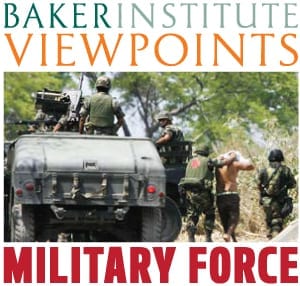While on the campaign trail, Enrique Peña Nieto — now Mexico’s president — sought to de-emphasize the military’s role in the drug war by supporting the creation of a national gendarme and the widespread expansion of the Todos Somos Juarez, a civil society development plan. Yet the proliferation of vigilantes taking up arms to defend their villages against drug-related violence recently forced the federal government to send soldiers to Michoacán. Like his predecessor, Felipe Calderón, Peña Nieto seems poised to again put his country’s military front and center in the fight against cartels. In the third of a five-part Baker Institute Viewpoints series, we evaluate a fundamental question for all democratic societies facing organized crime threats: Is the deployment of troops in a domestic conflict with organized crime an appropriate use of combat forces?
When a nation deploys its regular armed forces in response to a purely internal disturbance, it normally indicates that the nature of that disturbance has crossed a legally and operationally critical threshold from normal to extraordinary. As a general proposition, national armed forces are not established, trained or equipped for routine domestic use. Instead, they exist to defend the nation against external and internal threats that exceed the capacity of normal peacetime response authorities. What, then, is the significance of the increasing reliance by the Mexican government on regular armed forces to respond to the threat of armed and organized criminal gangs?
Armed forces are equipped and trained to effectively engage in hostilities. It is therefore logical to expect that resort to military force to respond to threats to the nation will normally be justified only when law enforcement authorities are unable to preserve public order and protect the population. Because, however, states also use military forces to augment police resources in response to situations that do not necessarily rise to the level of threat associated with armed hostilities, the legal and operational significance of such domestic use is extremely complicated.
From a legal perspective, assessing the character of the internal disturbance is critical to defining the response authorities these forces may utilize. Whenever a government uses any type of force in response to an internal challenge, a key question is whether the situation is governed by the legal framework normally applicable in times of peace, or whether the situation has triggered a state of armed conflict justifying use of the type of robust authority associated with “war.” If the situation does qualify as an armed conflict within the meaning of international law, military forces may invoke extraordinary measures to subdue the threat: attacking members of the internal dissident or belligerent group with deadly combat power; detaining captured members of such groups without charge or trial in order to prevent them from returning to hostilities; and subjecting such members to trial by military tribunal for allegations they violated the basic rules of war (for example, by attacking civilians, abusing captured government forces, or engaging in treacherous tactics).
Use of national military forces does not, however, automatically indicate a situation of armed conflict. Such forces may be used to augment civilian law enforcement capability in response to internal disturbances or natural disasters that do not involve a threat from an organized belligerent group or intense “hostilities” required to classify a situation as an armed conflict. Using the armed forces in these situations will certainly render the government response more robust, but these forces will be obligated to comply with normal law enforcement legal rules. Like police officers, military forces acting in such a “constabulary” role may only employ force when necessary to respond to an actual threat, may only employ force proportional to the threat they encounter, and must rely on normal criminal law process to apprehend and punish wrongdoers.
The contrast between these two legal response frameworks is illustrated by considering two distinct missions assigned to the U.S. armed forces. In response to the Los Angeles riots following the verdict in the Rodney King trial, President George H.W. Bush invoked the Insurrection Act and ordered active duty military forces to augment state and local police authorities to restore law and order. The civil unrest that necessitated this response may have overwhelmed police capabilities, but it did not rise to the level of an armed conflict. Accordingly, these forces were governed by law enforcement type rules for the use of force, and normal criminal process was used to criminally sanction wrongdoers. In contrast, the United States assessed the scope and intensity of the terrorist threat that produced the attacks of September 11, 2001, as rising to the level of an armed conflict. As a result, the armed forces employed to respond to this threat operated pursuant to conduct of hostilities rules derived from international law, authority that provides the legal foundation for incapacitating terrorist belligerent operatives to this day. This enabled this “enemy” to be attacked as a first resort with no requirement to exhaust capture as a first option, to be detained without trial to prevent return to hostilities, and to be tried by military commission.
What makes the situation in Mexico so complicated is that it seems to straddle the line between a law enforcement threat and an armed conflict. When the “law of internal armed conflicts” emerged in the 1949 Geneva Conventions, the international community simply did not contemplate that a criminal syndicate might produce the type of internal threat that crossed the threshold from peace to armed hostilities. However, the law was very much intended to provide a practical, de facto formula for assessing the existence of armed conflict. Since that time, the law has evolved to essentially recognize two essential elements for making this assessment: a contest between two organized belligerent groups (as opposed to disorganized internal violence), and an intensity of hostilities that is more than “isolated” acts of violence. Mexico certainly seems to have crossed this threshold long ago. There is no logical dispute to the conclusion that the level of violence has crossed the intensity threshold, and the criminal groups (some of which grew out of dissident members of the military) operate with many of the characteristics of organized insurgent groups. Finally, the fact that a state is compelled to resort to military force in response to a threat, while not dispositive of the nature of the situation, is treated as a highly probative indicator that the state considers the situation to be an armed conflict, even if it refuses to overtly acknowledge it as such.
Of equal significance, the situation in Mexico also illustrates why there is no rational reason a state should be barred from asserting armed conflict authority in response to a criminal threat. When criminal syndicates attain the level of organization that enables them to engage in routine and widespread hostile actions, and then do so, restricting government response authority to that associated with normal criminal threats will severely compromise that response. At a tactical level, it will also expose the armed forces to unjustifiable risk and cede “engagement initiative” to the opponent, for these forces will be obligated to use force only as a measure of last resort. Bringing groups like the Zetas into submission will arguably require a much more robust response authority. Acknowledging a situation of armed conflict facilitates that vital national strategic objective, and Mexico should not hesitate to do so when the facts on the ground and the nature of engagements indicate these are not constabulary operations.

Guest author Geoffrey S. Corn is a professor at the South Texas College of Law, where he specializes in criminal, military, national security and public international law. A retired U.S. Army lieutenant colonel, Corn has been named the law school’s professor and adviser of the year each year since 2008. His work has been published in journals ranging the Stanford Law and Political Review to the Journal of International and Humanitarian Legal Studies. He is the editor and lead author of a forthcoming book from Oxford University Press on “The Law of Military Operations.”
